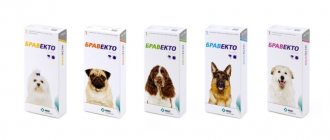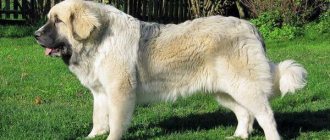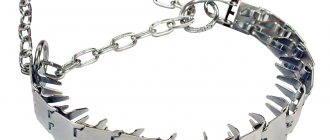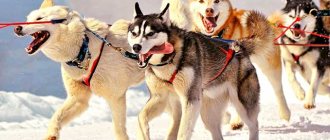What is meat and bone meal
Quite a healthy and nutritious product - a source of proteins. Natural meat and bone meal is produced from parts of a cattle carcass left over from the butchering of the animal after slaughter. The parts are not used for other purposes, but as a high-protein food additive, waste from canning and bacon production is quite suitable.
How is meat and bone meal produced? The process is organized so that during processing it kills all microorganisms and helminth larvae that could accidentally end up in parts of the carcass that are subject to grinding. The production of meat and bone meal for dogs takes place in workshops where sanitary and hygienic standards are observed. It is important that the manufacturer adheres to the rules, otherwise the feed additive may be harmful.
Briefly about the stages of production:
- meat products are placed in autoclaves for sterilization and steam treatment. During the process, microorganisms of various kinds die;
- the next stage is drying the disinfected raw materials. In the drying chamber, automation maintains high temperature and optimal pressure. The technology additionally protects the final product from dangerous inclusions;
- then the raw materials are passed through a crushing plant, sent to a special sifter with powerful magnets to remove metal particles and other foreign elements;
- the next stage is a sieve with smaller holes to clean the raw materials and remove large pieces. The finished product is more like ground coffee, the color is reddish-brown, the diameter of the grains is no more than 12 mm, there are light yellow inclusions (particles of baked and ground bones);
- prepared meat and bone meal is combined with antioxidants to prevent oxidation of the product and packaged in paper or cardboard packs;
- To store the nutritional supplement, a damp room with optimal humidity and temperature is required.
How and how to treat a pinched nerve in a dog? View a selection of effective treatment options.
Instructions for using the effective cardiotropic drug Vetmedin for small breed dogs are described on this page.
Production Features
Meat and bone meal for dogs is a crumbly powder with a specific odor, vaguely reminiscent of laundry soap. Normally, the product comes in different shades of brown and different grind sizes. It is sold in pet stores and pharmacies in soft packages of 0.5 kg, 1 kg.
For production, defective carcasses of large agricultural livestock are used. They are exposed to hot temperatures to sterilize and soften the bones.
After cooling, the mass is crushed and passed through a sieve. The finished flour is treated with an oxidizing agent and packaged in bags. At the end of each shift, all parts of production machines are mechanically cleaned and lubricated with an antibacterial agent.
Depending on the source raw material, bioadditives are divided into three categories:
1 – from livestock living in environmentally unfavorable conditions;
2 – from carcasses collected by municipal services;
3 – from animals growing on farms recognized as suitable for human consumption.
Bone meal for puppies and weakened pets should be of the third category. Product classification information can be found on the nutritional supplement packaging.
Composition and features of the product
Components of meat and bone meal for dogs:
- pure protein – about 50% of the total volume;
- a mixture of miro- and macroelements (ash fractions) – the content reaches 36–38%;
- lipids (fats) – about 20%;
- glutamic acid and ATP;
- thyroxine;
- serotonin;
- calcium (content higher than in meat flour: bones are used as one of the starting products);
- bile acids;
- kartinin.
Meat and bone meal contains water: the standard according to the standards is no more than 7%. An increase in the indicator indicates improper storage conditions, which increases the risk of mold development in the natural product.
How to determine product quality
When purchasing, you need to pay attention to the expiration date, the manufacturing company, and the appearance of the packaging. It is important that the paper packaging is not damp, with mold stains, gray-black or yellowish-green traces of dried moisture and traces of the activity of pathogenic flora.
Signs of high-quality meat and bone meal:
- color – reddish-brown, there are yellowish-white inclusions (ground bones after heat treatment);
- the right smell - baked meat, mild, pleasant,
- the consistency resembles crumbs or ground coffee, without large lumps, practically not wet, crumbly, without “salting” when grinding the crumbs;
- sharp, unpleasant, musty odor, color change: yellowish or greenish, the formation of large conglomerates, pronounced manifestations of dampness - signs of a spoiled product;
Side effects
If the daily norm is not met, protein metabolism may be disrupted in the dog’s body. This condition often leads to the appearance of gout, characterized by the deposition of uric acid salts in the joints. Another disease is amyloidosis, that is, the accumulation of protein in soft tissues.
Meat and bone meal is not prescribed to dogs with diseases of the gastrointestinal tract. In addition, the product may cause allergies or individual intolerances. It manifests itself as itching, hair loss, and digestive disorders.
Improper storage of the product can cause painful symptoms even in completely healthy dogs. Therefore, pay attention to the following points:
- Do not use the product after the expiration date.
- Do not store it in a warm, humid room;
- Avoid direct sunlight;
- Keep the supplement in an airtight container.
Benefits and harms
Advantages:
- source of natural proteins;
- high percentage of micro- and macroelements;
- high-quality food supplement to enrich the diet.
Flaws:
- spoils quickly: contains a lot of fat;
- storage rules must be strictly observed to avoid clumping and colonization of mold fungi;
- Exceeding the norm of a food additive clogs the digestive tract of animals, leading to constipation and intestinal obstruction;
- almost complete absence of vitamins;
- there is no plant fiber, frequent addition to the diet provokes constipation.
Use for puppies and adult dogs
Meat and bone meal is a cheaper product than natural beef, chicken, and turkey, but you cannot build a diet based on crumbs with bones and processed carcass residues. It is no coincidence that the ground product is called a “food additive” everywhere, which indicates dietary restrictions for dogs of all breeds. The desire to save on the amount of meat results in serious diseases of the gastrointestinal tract for your four-legged pet.
The dosage of meat and bone meal is an important nuance that you need to pay attention to. Owners of four-legged pets should be aware of the negative consequences of exceeding the norm. The amount of meat and bone meal in the diet of various breeds depends on the weight of the pet: small dogs - no more than 7%, medium breeds - up to 15%. For animals of large and giant breeds, it is allowed to increase the rate of meat and bone meal to 20%.
It is strictly forbidden to exceed the specified values: problems with the digestive organs are possible, and in severe cases, intestinal obstruction. Breeders and amateur dog breeders should remember: heat-treated meat products do not replace natural meat, but serve as a supplement to the main source of animal proteins.
Important! Meat and bone meal is added to the cooled porridge, but under no circumstances should you cook the crumbs with bones and processed products along with the main dish. A swollen product more actively “clogs” the intestines, leading to clogging of the digestive tract and constipation.
Indications
Veterinarians recommend giving a food supplement with proteins and microelements:
- for puppies to strengthen bones: meat and bone meal contains a high percentage of calcium;
- During examination, the animal was found to have a deficiency of mineral components, against which rickets and other lesions of the musculoskeletal system develop. Natural supplement replenishes the level of phosphorus, calcium, magnesium;
- for puppies when changing teeth, taking into account the norm for a particular breed;
- when identifying metabolic disorders that negatively affect the balance of minerals;
- during pregnancy;
- for older dogs to prevent joint deformation.
How and from what to make clothes for a toy terrier dog with your own hands? Look at the step-by-step algorithm of actions.
A list and rules for using broad-spectrum antibiotics for dogs can be seen in this article.
On the page you can learn about how colds manifest in dogs and how to treat a viral disease.
How often to give
Meat and bone meal is included in the diet two to three times a week. You should not give a natural product too often: the stomach and intestines may become clogged, which leads to constipation. Be sure to follow the norm and not exceed the percentage of the total weight of food for different breeds of dogs.
Many premium and higher category foods (super premium) also contain meat and bone meal. The difference is in percentage. Elite varieties include a small percentage of natural additives; in cheaper dog food, the amount of natural meat is less, but meat-and-bone meal and offal replace the main animal component.
Instructions for use
An excess of minerals is just as harmful as a deficiency. Therefore, when adding complementary foods, you should strictly follow the instructions for use.
The daily norm for puppies older than two months and pregnant bitches is 10 grams per 10 kg of body weight. The dose should be especially accurately calculated for children of small dogs (Yorkies, Pekingese, Toy Terriers). Veterinarians recommend dividing this portion into several feedings.
Adult dogs are prescribed 5 grams per 10 kg of live weight. Flour can be mixed with food, natural products, cottage cheese, kefir, and water. The owner must ensure that the portion is eaten without leaving a trace. If shepherd dogs, huskies and other large dogs regularly chew pork and beef bones, the dosage of the dietary supplement is reduced.
Cost and storage rules
The price of 1 kg of meat and bone meal is low - from 20 to 40 rubles. When purchasing large quantities you can save a lot.
Meat and bone meal is useful only if the storage conditions are followed:
- damp, ventilated room;
- temperature from +20 to +30 degrees;
- the packaging is closed after each portion of nutritious flour is taken;
- the multilayer paper bag should not be placed next to heating devices or in the sun.
It is forbidden to give the ground product to a dog of any age or breed if the storage rules are violated, if the mass is damp and lumpy. Also, a responsible owner knows when the expiration date of meat and bone meal expires and does not give the pet an expired natural supplement.
Bone meal production technology
To produce flour, they use the carcasses of animals that died from non-communicable diseases or waste from meat processing companies and factories.
Raw materials are first checked for the presence of various infections. The carcasses of animals that died from infectious viral diseases are disposed of and not used for making flour.
The production technology of the mineral additive is as follows:
- Carcasses or meat waste are checked by a veterinarian and allowed for processing.
- The raw materials are well crushed, boiled, and then cooled to a temperature of 24-25 degrees.
- The resulting boiled and cooled mixture is twisted to obtain a homogeneous mass.
- The raw materials are sent to a centrifuge, where excess water and fat are removed from it, after which the mixture is loaded into a special bunker. The mixture of fat and water enters a separator or settling tank. There the fat is separated and sent for further processing.
- After settling in the bunker, the mixture is sent for drying.
- After thorough drying, the raw materials are loaded into a crusher, where they are well crushed and sterilized.
- The finished and sifted product is sent to a bunker, and then it begins to be packaged and packaged.
Production of meat and bone meal
The dried meal is packaged in 50 kg bags made of thick paper or fabric, then they are sewn up with strong thread. The fat that was obtained during the processing process is packaged in boxes with a polyethylene layer.
Can be stored for 6 months at room humidity not higher than 75% and temperature from 0 to +30 degrees.
In sealed containers, shelf life is extended to 12 months.
Alternative to meat and bone meal
As recommended by your veterinarian, puppies and adult dogs receive other types of vitamin and mineral supplements to strengthen their bones and teeth. Calcium phosphate, ground eggshells, Hercules cereal, sea fish, offal, low-fat cottage cheese, blood, milk are food names that replace meat and bone meal. It is important to remember: the main source of proteins and minerals is natural lean meat.
For the proper development of four-legged pets, the menu must contain proteins, mineral components, and lipids. Meat and bone meal is a food additive to the diet of dogs of all breeds. It is important to give your pet a natural product, taking into account the norm for a particular breed, in order to avoid clogging of the digestive tract. Meat and bone meal must be of high quality and not expired. You cannot replace natural meat with a cheap food additive.
Share this article with your friends:











